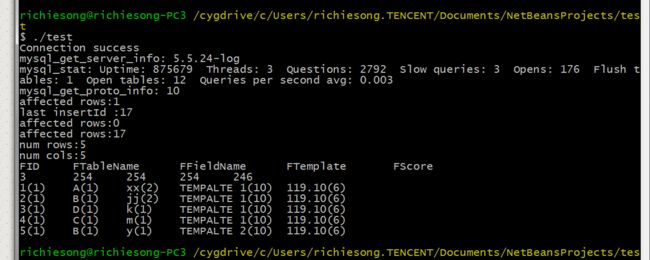C语言操作mysql
php中 mysqli, pdo 可以用 mysqlnd 或 libmysqlclient 实现
前者 从 php 5.3.0起已内置到php中, 并且支持更多的特性,推荐用 mysqlnd
mysqlnd , libmysqlclient 对比:
http://php.net/manual/en/mysqlinfo.library.choosing.php
mysqlnd 目前是php源码的一部分
http://php.net/manual/en/intro.mysqlnd.php
php编译参数:
// Recommended, compiles with mysqlnd $ ./configure --with-mysqli=mysqlnd --with-pdo-mysql=mysqlnd --with-mysql=mysqlnd // Alternatively recommended, compiles with mysqlnd as of PHP 5.4 $ ./configure --with-mysqli --with-pdo-mysql --with-mysql // Not recommended, compiles with libmysqlclient $ ./configure --with-mysqli=/path/to/mysql_config --with-pdo-mysql=/path/to/mysql_config --with-mysql=/path/to/mysql_config
环境准备:
1、安装 libmysqlclient
http://cdn.mysql.com/Downloads/Connector-C/mysql-connector-c-6.0.2.tar.gz
-
Change location to the top-level directory of the source distribution.
-
Generate the
Makefile:shell>cmake -G "Unix Makefiles"Or, for a Debug build:
shell>cmake -G "Unix Makefiles" -DCMAKE_BUILD_TYPE=DebugBy default, the installation location for Connector/C is
/usr/local/mysql. To change this location, use theCMAKE_INSTALL_PREFIXoption to specify a different directory when generating theMakefile. For example:shell>cmake -G "Unix Makefiles" -DCMAKE_INSTALL_PREFIX=/opt/local/mysqlFor other CMake options that you might find useful, see Other Connector/C Build Options.
-
Build the project:
shell>make -
As
root, install the Connector/C headers, libraries, and utilities:root-shell>make install
示例代码:
//main.c //gcc main.c -o test -lmysqlclient // @link http://dev.mysql.com/doc/refman/5.6/en/c-api-function-overview.htm // libmysqlclient library #include <stdio.h> #include <stdlib.h> #include <mysql/mysql.h> MYSQL *get_conn() { //连接配置 char *host = "127.0.0.1"; char *user = "root"; char *passwd = ""; char *db = "test"; int port = 3306; my_bool reconnect = 1; MYSQL *my_con = (MYSQL *)malloc( sizeof(MYSQL) ); //数据库连接句柄 //连接数据库 mysql_init(my_con); mysql_options(my_con, MYSQL_OPT_RECONNECT, &reconnect); mysql_real_connect(my_con, host, user, passwd, db, port, NULL, CLIENT_FOUND_ROWS); mysql_query(my_con, "set names utf8"); return my_con; } /** * 释放空间,关闭连接 * * @param mysql * @return */ void free_conn(MYSQL *mysql) { mysql_close(mysql); free(mysql); } //发生错误时,输出错误信息,关闭连接,退出程序 void error_quit(const char *str, MYSQL *connection) { fprintf(stderr, "%s\n errno: %d\n error:%s\n sqlstat:%s\n", str, mysql_errno(connection), mysql_error(connection), mysql_sqlstate(connection)); if( connection != NULL ) { mysql_close(connection); } free(connection); exit(EXIT_FAILURE); } void insert(MYSQL *my_con) { int res; res = mysql_query(my_con, "INSERT INTO test(fid) VALUES(null)"); if( res != 0 ) { error_quit("Select fail", my_con); } printf("affected rows:%d \n", mysql_affected_rows(my_con)); printf("last insertId :%d \n", mysql_insert_id(my_con)); } void update(MYSQL *my_con) { int res; res = mysql_query(my_con, "UPDATE test SET FScore=119.10"); if( res != 0 ) { error_quit("Select fail", my_con); } printf("affected rows:%d \n", mysql_affected_rows(my_con)); } void delete(MYSQL *my_con) { int res; res = mysql_query(my_con, "DELETE FROM test WHERE FID=31"); if( res != 0 ) { error_quit("Select fail", my_con); } printf("affected rows:%d \n", mysql_affected_rows(my_con)); } void query(MYSQL *my_con) { MYSQL_RES *my_res; //查询结果 MYSQL_FIELD *my_field; //结果中字段信息 MYSQL_ROW my_row; //结果中数据信息 unsigned long *lengths; int cols, res, i; //获取整个表的内容 res = mysql_query(my_con, "SELECT * FROM test LIMIT 5"); if( res != 0 ) { error_quit("Select fail", my_con); } /* mysql_query , mysql_real_query 区别 While a connection is active, the client may send SQL statements to the server using mysql_query() or mysql_real_query(). The difference between the two is that mysql_query() expects the query to be specified as a null-terminated string whereas mysql_real_query() expects a counted string. If the string contains binary data (which may include null bytes), you must use mysql_real_query(). */ //从服务端取回结果 mysql_store_result 会把数据全部拉取到客户端, mysql_use_result() 则不会 my_res = mysql_store_result(my_con); // A MYSQL_RES result structure with the results. NULL (0) if an error occurred or has not result like delete if( NULL == my_res ) //可以通过返回值来判断是否是 select { error_quit("Get result fail", my_con); } // mysql_row_seek(), mysql_data_seek() , mysql_num_rows 只有在用mysql_store_result 才可以使用 printf("num rows:%d \n", mysql_num_rows(my_res)); //获取表的列数 cols = mysql_num_fields(my_res); printf("num cols:%d \n", cols); //获取字段信息 my_field = mysql_fetch_fields(my_res); for(i=0; i<cols; i++) { printf("%s\t", my_field[i].name); } printf("\n"); for(i=0; i<cols; i++) { //字段类型 printf("%d\t", my_field[i].type); } printf("\n"); //输出执行结果 while( my_row = mysql_fetch_row(my_res) ) { for(i=0; i<cols; i++) { //数据长度 lengths = mysql_fetch_lengths(my_res); printf("%s(%lu)\t", my_row[i], lengths[i]); } printf("\n"); } mysql_free_result(my_res); } void status(MYSQL *my_con) { printf("mysql_get_server_info: %s \n", mysql_get_server_info(my_con)); printf("mysql_stat: %s \n", mysql_stat(my_con)); printf("mysql_get_proto_info: %u \n", mysql_get_proto_info(my_con)); } int main(int argc, char *argv[]) { //连接数据库 MYSQL *my_con = get_conn(); if( NULL == my_con ) { error_quit("Connection fail", my_con); } printf("Connection success \n"); status(my_con); insert(my_con); delete(my_con); update(my_con); //select query(my_con); // free the memory free_conn(my_con); return EXIT_SUCCESS; }
test.sql
/* Navicat MySQL Data Transfer Source Server : localhost Source Server Version : 50524 Source Host : 127.0.0.1:3306 Source Database : test Target Server Type : MYSQL Target Server Version : 50524 File Encoding : 936 Date: 2015-09-16 15:02:57 */ create DATABASE test; SET FOREIGN_KEY_CHECKS=0; -- ---------------------------- -- Table structure for `test` -- ---------------------------- DROP TABLE IF EXISTS `test`; CREATE TABLE `test` ( `FID` int(11) NOT NULL AUTO_INCREMENT, `FTableName` char(60) NOT NULL DEFAULT '', `FFieldName` char(30) NOT NULL DEFAULT '', `FTemplate` char(30) NOT NULL DEFAULT '', `FScore` decimal(5,2) NOT NULL DEFAULT '0.00' COMMENT 'ио╩§', PRIMARY KEY (`FID`) ) ENGINE=MyISAM AUTO_INCREMENT=18 DEFAULT CHARSET=latin1; -- ---------------------------- -- Records of test -- ---------------------------- INSERT INTO test VALUES ('1', 'A', 'xx', 'TEMPALTE 1', '119.10'); INSERT INTO test VALUES ('2', 'B', 'jj', 'TEMPALTE 1', '119.10'); INSERT INTO test VALUES ('3', 'D', 'k', 'TEMPALTE 1', '119.10'); INSERT INTO test VALUES ('4', 'C', 'm', 'TEMPALTE 1', '119.10'); INSERT INTO test VALUES ('5', 'B', 'y', 'TEMPALTE 2', '119.10'); INSERT INTO test VALUES ('6', 'D', 'k', 'TEMPALTE 2', '119.10'); INSERT INTO test VALUES ('7', 'C', 'm', 'TEMPALTE 2', '119.10'); INSERT INTO test VALUES ('8', 'E', 'n', 'TEMPALTE 2', '119.10'); INSERT INTO test VALUES ('9', 'D', 'z', 'TEMPALTE 3', '119.10'); INSERT INTO test VALUES ('10', 'E', 'n', 'TEMPALTE 3', '119.10'); INSERT INTO test VALUES ('11', 'A', 'x', 'TEMPALTE 2', '119.10'); INSERT INTO test VALUES ('12', 'A', 'x', 'TEMPALTE 3', '119.10'); INSERT INTO test VALUES ('13', 'A', 'x', 'TEMPALTE 4', '119.10'); INSERT INTO test VALUES ('14', 'E', 'p', 'TEMPALTE 4', '119.10'); INSERT INTO test VALUES ('15', 'A', 'x', 'TEMPALTE 5', '119.10'); INSERT INTO test VALUES ('16', 'C', 'q', 'TEMPALTE 5', '119.10'); INSERT INTO test VALUES ('17', '', '', '', '119.10');
参考文档:http://dev.mysql.com/doc/refman/5.6/en/c-api-function-overview.html
http://www.linuxfocus.org/ChineseGB/September2003/article304.shtml#304lfindex3
